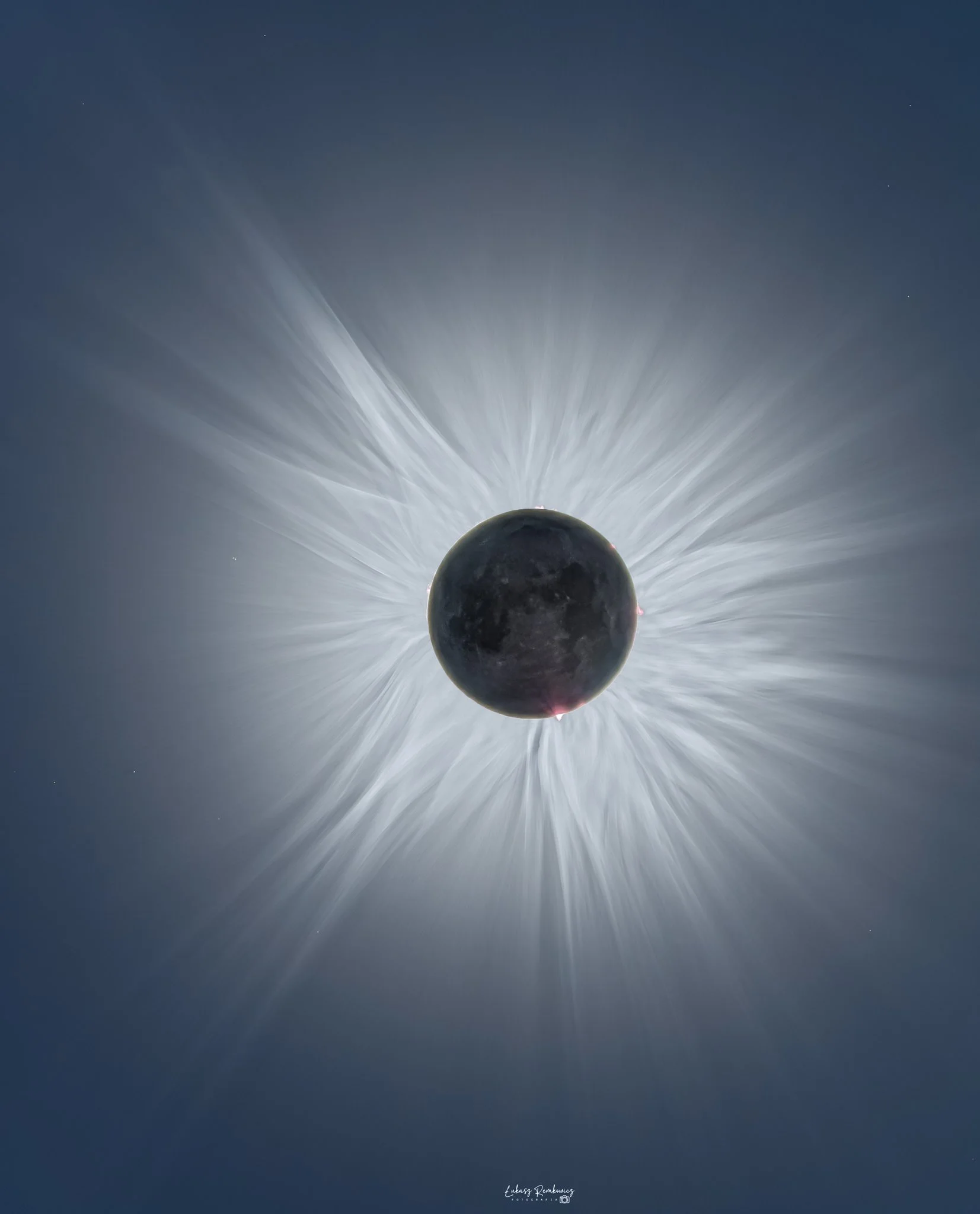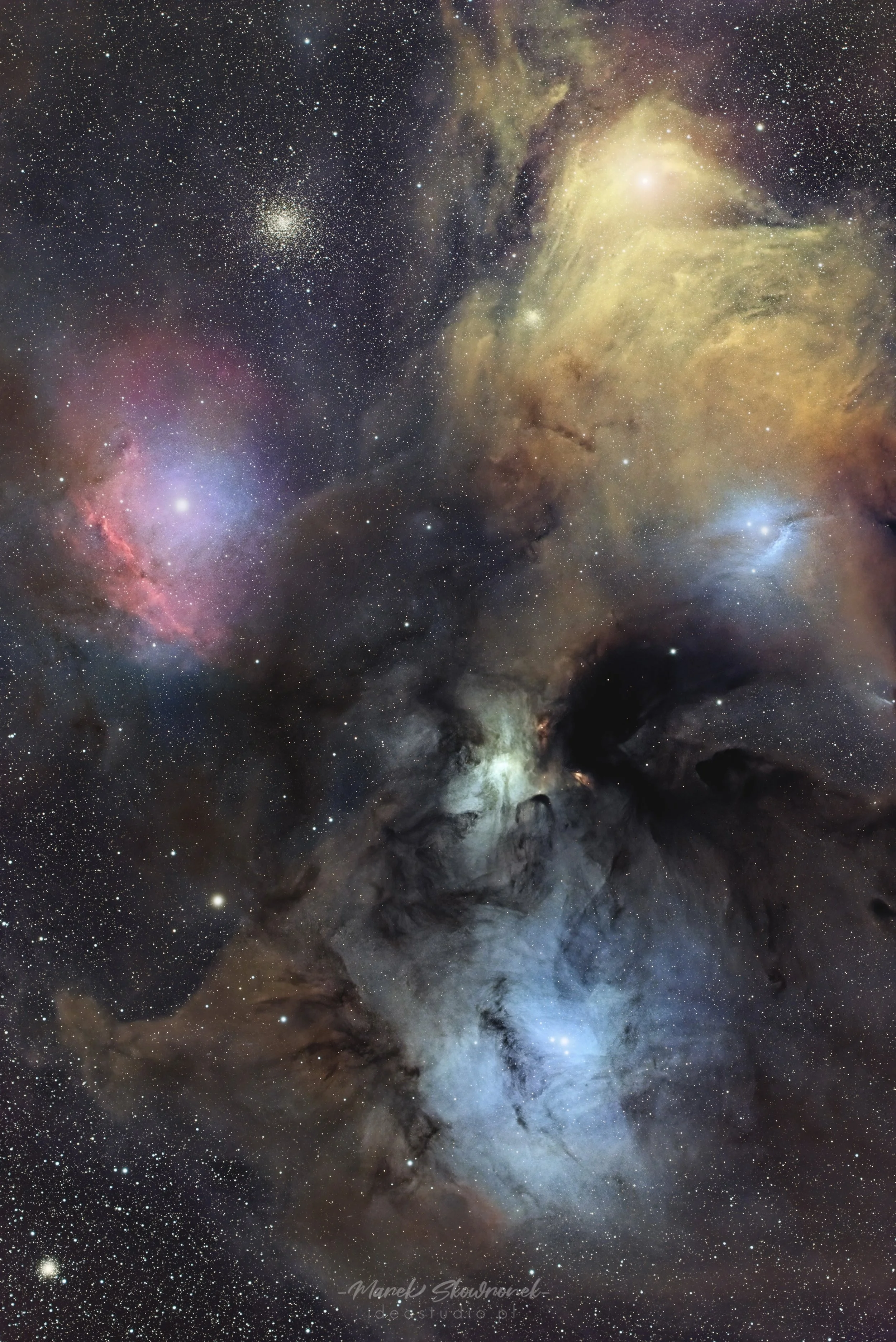
AAPOD2 Image Archives
June 2024
Monthly AAPOD2 Winners
Solar Total Eclipse (HDR)
This HDR composite image of the Solar Total Eclipse, photographed in Arkansas, USA, captures the celestial event in stunning detail. The image is a blend of nine different exposures, ranging from 1/200 to 1.3 seconds, meticulously combined to reveal the intricate details of the eclipse. Visible in the photograph are the moonshine, the Sun's corona, and several solar protuberances, showcasing the dynamic interplay between the Moon and the Sun during this rare alignment.
The blending of multiple exposures allows for a comprehensive view of the eclipse, balancing the brightness of the Sun's corona with the subtle glow of the moonshine. The Sun's corona, the outermost part of its atmosphere, appears as a halo of plasma, visible only during a total solar eclipse. The solar protuberances, or prominences, are large, bright features extending from the Sun's surface, composed of hot ionized gases. This detailed capture not only highlights the beauty of the eclipse but also provides a scientific glimpse into the complex phenomena occurring in our solar system.
A Blade in the Sky (12P/Pons-Brooks)
Comet 12P/Pons-Brooks, discovered by Jean-Louis Pons and William Robert Brooks, is currently putting on a spectacular show in the night sky. This comet, with its characteristic bright coma and long, luminous tail, has earned the nickname "the Blade" due to its distinctive, sharp appearance against the backdrop of the cosmos. The tail of the comet, composed of dust and gas, stretches across the sky, reflecting sunlight and creating a mesmerizing display.
As 12P/Pons-Brooks traverses its highly elliptical orbit around the Sun, it offers a unique opportunity for both amateur and professional astronomers to study its composition and behavior. Comets like Pons-Brooks are considered ancient relics from the early solar system, providing valuable insights into the conditions and materials present during its formation. Observing this celestial spectacle not only brings beauty to the night sky but also contributes to our understanding of the solar system's history.
Milky Way and STEVE
STEVE, or Strong Thermal Emission Velocity Enhancement, is a fascinating atmospheric phenomenon distinct from typical auroras. Unlike the common green and red hues of auroras caused by charged particles from the solar wind interacting with Earth's magnetic field, STEVE appears as a purplish arc with "picket fence" structures of green light. This phenomenon has intrigued scientists and citizen scientists alike, leading to its formal identification and study in recent years.
STEVE occurs at lower latitudes compared to traditional auroras and is associated with high-speed streams in the upper atmosphere. The exact mechanisms behind STEVE are still under investigation, but it is believed to involve different physical processes, possibly related to ionospheric heating and particle precipitation. Observations of STEVE, often captured by amateur photographers and skywatchers, provide valuable data that help scientists better understand the complex interactions between solar activity and Earth's magnetosphere.
The Cat's Eye Galaxy
Messier 94 (NGC 4736) is a striking spiral galaxy located approximately 16 million light-years away in the constellation Canes Venatici. This galaxy is known for its bright, star-forming ring, which surrounds a prominent central region. The ring is an area of intense star formation, giving M94 its unique and vibrant appearance. The galaxy's tightly wound spiral arms and bright nucleus make it a popular target for both professional and amateur astronomers.
One of the interesting features of M94 is its classification as a double-ringed galaxy, with an inner ring of young, hot stars and an outer ring that is more diffuse. The galaxy's inner region is dominated by older stars and shows little evidence of star formation. The distinct rings are thought to be caused by waves of density propagating through the galaxy, compressing gas and triggering star formation as they go. This fascinating structure offers valuable insights into the dynamics of spiral galaxies and the processes that drive star formation.
SH2-91: The Other Veil
Sh2-91 is a faint and intricate supernova remnant located in the constellation Cygnus, also known as the Network Nebula. This remnant is part of a larger supernova event that occurred thousands of years ago, scattering stellar material across the region. It is characterized by its delicate filaments of gas and dust, glowing predominantly in hydrogen-alpha light, which creates a striking visual of interwoven tendrils against the backdrop of the Milky Way.
The distance to Sh2-91 is estimated to be around 2,600 light-years from Earth. This remnant is particularly interesting to astronomers due to its complex structure and the insights it provides into the aftermath of supernova explosions. The remnants of the progenitor star interact with the surrounding interstellar medium, offering clues about the life cycle of stars and the dynamics of supernova remnants. Sh2-91, with its ethereal appearance, is a testament to the powerful and violent processes that shape our galaxy.
Colliding Spirals - NGC 4038 & 4039 - The Antennae Galaxies
NGC 4038 and NGC 4039, collectively known as the Antennae Galaxies, are a pair of colliding spiral galaxies located about 60 million light-years away in the constellation Corvus. These galaxies are named for their long, antenna-like tidal tails of stars and gas, formed by the gravitational forces of their interaction. This cosmic collision has been ongoing for hundreds of millions of years, resulting in spectacular formations and triggering intense regions of star formation.
The Antennae Galaxies provide a vivid snapshot of galactic evolution and the processes that occur when galaxies merge. The collision has compressed vast clouds of gas and dust, leading to the birth of new stars and massive star clusters, some of which are among the brightest and most massive known. Observations in various wavelengths, from visible light to X-rays, reveal the complex structure and dynamic activity within these interacting galaxies, offering valuable insights into the life cycles of galaxies and the role of cosmic collisions in shaping the universe.
Complex Ro Ophiuchi
The Complex Ro Ophiuchi, one of the most striking and vivid regions in the Milky Way, dazzles with its intricate interplay of dust, gas, and starlight. This star-forming region, located about 460 light-years away in the constellation Ophiuchus, showcases a remarkable tapestry of colors and textures. The image reveals a rich canvas where deep, dark nebulae contrast sharply with bright, reflective regions illuminated by newborn stars. The vibrant blues and reds hint at the presence of hot, young stars and their energetic interactions with the surrounding interstellar medium. This dynamic environment is a hotbed of stellar activity, where the forces of gravity and radiation shape and mold the cosmic landscape into a mesmerizing celestial masterpiece.
In the heart of the Ro Ophiuchi complex lies the brilliant star Rho Ophiuchi, whose intense light scatters off the nearby dust, creating a striking reflection nebula. The dense clouds of dust and gas are not just picturesque but are also fertile grounds for star formation. Within these obscuring veils, protostars are born, eventually emerging as fully-fledged stars that will light up the galaxy. This region's proximity and activity make it an invaluable laboratory for studying the early stages of stellar evolution. Through this breathtaking image, we get a glimpse into the ongoing processes that have shaped our own solar system, revealing the timeless beauty and complexity of the universe.
M57: The Ring nebula
The Ring Nebula, also known as Messier 57 (M57), is a classic planetary nebula located in the constellation Lyra, about 2,300 light-years away from Earth. This nebula is the remnants of a star similar in mass to the Sun, which shed its outer layers as it reached the end of its life cycle. The expelled material forms the characteristic glowing ring, while the hot core of the star, now a white dwarf, illuminates the nebula from within.
M57 is a well-studied object due to its bright and distinctive appearance, making it a popular target for both amateur and professional astronomers. The nebula's ring structure is primarily composed of ionized hydrogen and helium, which emit light in vivid colors, typically seen in red and green hues through telescopes. Observations have revealed intricate details within the nebula, including knots and filaments of gas, which provide insights into the processes of stellar evolution and the dynamic interactions between the ejected material and the surrounding space.










